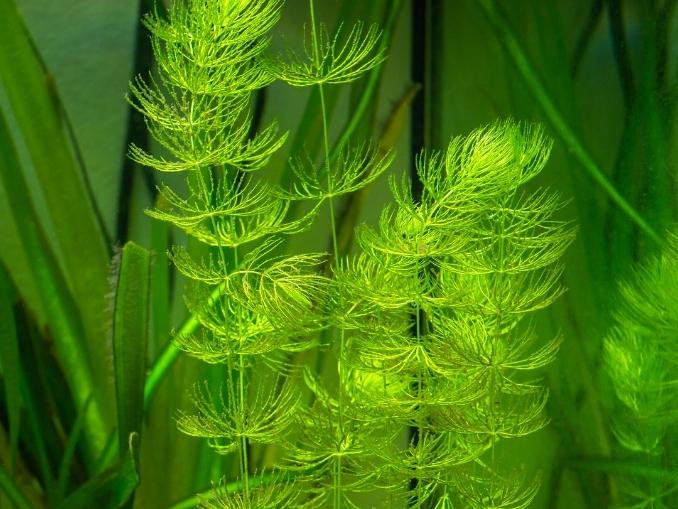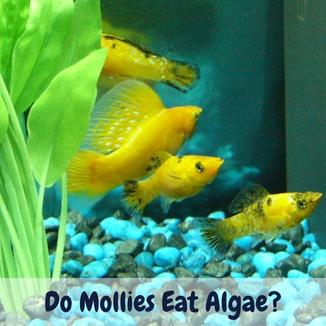Mollies are among the most common choices for aquarists due to their lovely appearances and low cost. Furthermore, if taken care of properly, mollies can surely last for a long time. And even better? Instead of being merely decorative, mollies can serve other purposes as well!
In today’s article, let’s have a look at whether “Do mollies eat algae?” Scroll down and see if these active animals can also handle the task of algae control!
Contents
Do Mollies Eat Algae
Yes, mollies do eat algae. That said, you should be aware of how mollies are not fully considered as algae eaters. This means that these animals still enjoy feeding on algae from time to time.
But if given the choice, they would not be too enthusiastic about eating algae. Instead, mollies prefer a more diverse diet where they get to consume both plant matter and protein-rich food.

What Types Of Algae Do Mollies Eat?
In most tanks, you are likely to find four types of algae.
First, it is brown diatom algae. They are mostly found in newly planted tanks, especially where the conditions are rife with silicates and phosphates. Brown diatom algae tend to cover open surfaces and tank walls.
Second, it is hair algae. As the name already indicates, hair algae look like hair falling from the plants and crevices. They are notorious for their quick reproducing rate and are not easy to kill off.
Third, it is black beard algae. This type of algae gets its name from its appearance, which looks like a bunch of hair getting stuck on the surface.
Finally, it is green spot algae. Green spot algae can only be found on tank walls, where they form sticky spots that are nearly impossible to clean.
Now, out of these four types of algae, mollies enjoy hair algae the best. Not only are hair algae nutritious, but they are also fun to chew on. But the rest are not so lucky. Mollies detest black beard algae and are only mildly interested in brown diatom algae and green spot algae.
Can Algae-eaters Live With Mollies?
Yes. While mollies are not algae-eaters themselves, they can still live with those who are. That said, you might have to check out the temperament of the fish you decide to pair with mollies. If they prove to be too aggressive or belligerent, chances are your mollies might be threatened and even hurt.
Remember, when it comes to building a community tank, the difference in diets is not that important. What counts is the fish’s temperament and how well it could adjust to new lives.
What Plants Do Molly Fish Like?

Mollies are big fans of plants for two main reasons. Firstly, aquatic plants provide mollies with a hiding place and playground. This way, mollies can lurk around and have fun with one another while seeking refuge from potential threats.
Secondly, plants inside an aquarium can prove to be a useful source of snacks for mollies. While these fish are not too voracious, they might enjoy having something to chew on occasionally.
Generally speaking, mollies prefer live plants with smooth surfaces. This ensures that mollies do not get stuck easily due to their sticky skin. The list includes hornwort, anubias, java fern, as well as other tall, sheltering plants.
Do Mollies Produce A Lot Of Waste?
Yes. As mentioned above, mollies are not too voracious eaters. However, if you feed them constantly and the protein received is in high concentration, then mollies can end up pooping quite a lot.
This explains why a tank with mollies may get murky and dirty rather quickly.
To counter this problem, it is essential that you keep mollies’ diet to a recommended frequency. Refrain from overfeeding them, and consider fasting them for a day or two if the situation provides too dire.
While some fish have no problem consuming their poop, mollies are not one of them. You cannot expect these fish to get rid of the waste themselves. Hence, scooping the poop out and cleaning the water tank is a must if you want the tank to stay clean.
What Kind Of Food Do Mollies Eat?
Wild mollies eat a wide range of food, considering their status as omnivores. Not only can they take in algae and other plant matter, but they can also feed on small invertebrates.
Since you are not likely to find these types of food for captivated mollies, it is best that you replace them with blanched veggies (cucumber slices, spinach, etc,.) and flakes food. You can also diversify the diet by adding live food such as brine shrimp or bloodworms.
Are Mollies Helpful For Home Tanks?
It depends on your preference regarding what is helpful and what is not. Granted, mollies are not as effective algae-eaters as others. They also poop a lot and may end up getting your tank rather dirty.
But on the other hand, mollies come with a wide variety of beautiful, lovely species. They are amazing to look at and do not cost you tons of money in the first place. That is not to mention how mollies are low-maintenance and can probably last for a long time.
Last but not least, in any case, you can still rely on mollies to get rid of hair algae and brown diatom algae.
Admittedly, their eating speed is not that impressive. But still, it is better to have something both aesthetically pleasing and useful inside your home tank, right?
Conclusion
Do mollies eat algae? Yes, they do! Apart from black beard algae, mollies will happily feed on the most common types of algae your tank has, especially hair algae. So make sure to satisfy your fish by letting them feed on algae!

